
Like many others, I read Jack London's 1903 short novel Call of the Wild in school in my pre-teen years. In my head, I never pictured Harrison Ford as John Thornton, and I struggled to completely picture a version of Buck big enough to scare a bear. In truth, though, I didn't know how any film could safely pull off all of the events in the novel without probably killing multiple dogs. At that point in my life, there had only been three different films that even tried, and the one from 1935 puts its version of Buck through so much Clarke Gable - that film's Thornton - later claimed to have felt bad for the poor pup.
There have since been two more live-action film adaptations: Rutger Hauer's Call of the Wild: Dog of the Yukon (1997) and the Harrison Ford-starrer playing in theaters right now. Haven't see Dog of the Yukon. Just got back from the Harrison Ford version. Quick question: can I even call this movie live-action?
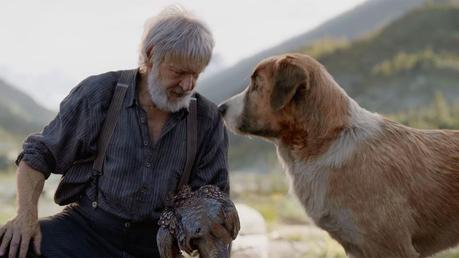
Can Call of the Wild be considered live-action if most of it was filmed on Los Angeles soundstages in front of a green screen? Can you call it animation even though there are real, living, breathing human beings like Harrison Ford, Omar Sy, Cara Gee, Karen Gillan, and Dan Stevens in the cast? Are the various dogs in the movie, including Buck, the result of mo-capped CGI like Gollum (from Lord of the Rings/ Hobbit), Caesar (from the recent Planet of the Apes trilogy), and Rocket Raccoon (from Guardians of the Galaxy)? Or are they closer to the VR animals and environments of Jon Favreau's The Lion King?
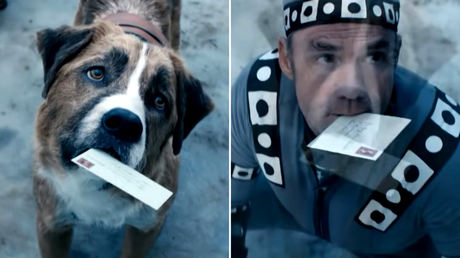 Buck on left, Buck's human stand-in Terry Notary, in mo-cap suit, on right
Buck on left, Buck's human stand-in Terry Notary, in mo-cap suit, on right Ah. Got it. More Avatar live-action/CGI hybrid territory, less Lion King's "VR-fueled future of cinema," as Wired put it. The distinction between the two might not seem significant, but it is important to understand how new this technology is because it helps us judge its effectiveness. What Jon Favreau did with Lion King is so new he doesn't even know what to call it, telling Wired, "We'll probably have to come up with some sort of new language." What animation-veteran-turned-director Chris Sanders did with Call of the Wild is more like playing within the established rules.
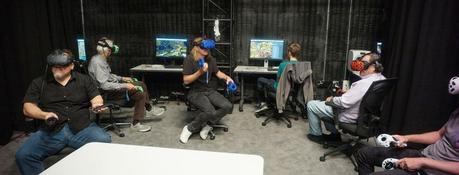 No, that's not an Esports match - it's Jon Favreau and crew using VR headsets to compose shots for The Lion King.
No, that's not an Esports match - it's Jon Favreau and crew using VR headsets to compose shots for The Lion King.
Such hand-wringing, however, misses the point. The question shouldn't be how Call of the Wild was made; it should be whether or not the film is any good. In this case, however, the two are inexorably linked because as brilliantly as this tech has been deployed elsewhere Call of the Wild proves that not everyone can pull it off convincingly. Buck - the 140-pound Collie mix that begins the story as the spoiled dog of a rich judge and ends up sold into service as sled dog in the Alaskan Yukon during the 1890s Gold Rush - far too frequently resembles a cartoon with eyes more expressive than any actual St. Bernard found in nature.
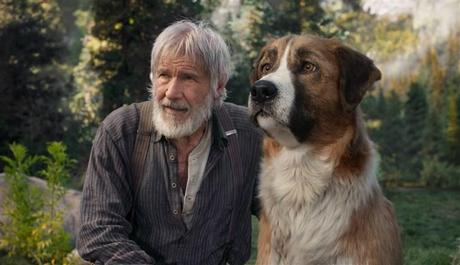
In those sequences in which Buck interacts with humans, there's not only an uncanny valley to it all but also misaligned sightlines and the occasional CGI halo signaling that the dog on screen isn't real and doesn't blend as seamlessly with the background imagery as it should. On the flip side, when Buck is merely interacting with nature and other CGI dogs that usually means you're watching 100% animated material and it looks as convincing as it needs to be - not as stunningly photorealistic as a Jungle Book or Lion King, but good enough to entertain.
Is this disconnect too big to ignore? Or can Call of the Wild be enjoyed as a perfectly fine family film that sanitizes the rougher edges of the London story - spoiler, Buck does NOT vengeance-kill any Native Americans in this version - and utilizes tech that is just good enough to keep the locals happy?
The critical reaction seems divided, with many quick to do their best Jeff Goldblum...
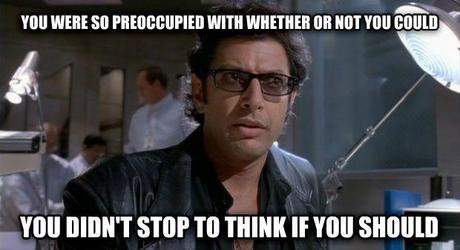
...in arguing that there was no reason Call of the Wild needed to be made this way. "But The Call of the Wild is a story where realism should have counted for something, and instead, because the technology exists to do it this other way, we've been served up with a kind of digital theme-park," The Telegraph 's Robbie Collins argued.
There are still filmmakers doing it the old way. Heck, some of them even work for Disney. Togo - a Disney+ Original I'd highly recommend even though no one seems to have actually watched it - stars Willem Defoe and real dogs plucked from The Snowy Owl Sled Dog Tours Inc. It's based on the famous 1925 incident where a man and his sled dogs, led by a fearless Siberian Husky named Togo, traversed miles of Alaskan snow and ice to deliver a much-needed antitoxin to a town suffering a diphtheria epidemic. (I'm simplifying here.) To bring this to life, Director Ericson Core took Dafoe, the rest of the cast and crew up to Alberta, Canada, and they just filmed the damn thing - quite clearly substituting CGI snow and ice when necessary, but doing much of it practically.
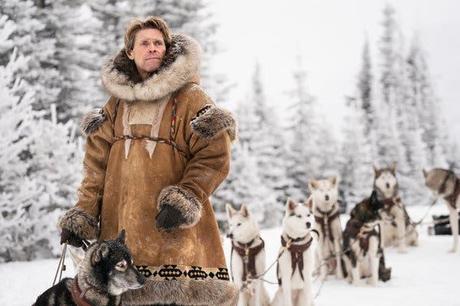 Dafoe and his good dogs in Togo
Dafoe and his good dogs in Togo Doing it practically used to be the only real choice you had. For example, in 1990 when Ethan Hawke starred in an adaptation of London's other famous novel, White Fang, they did it all in Alaska with wolfdogs. No amount of computer trickery can truly replicate that kind of authenticity.
There is certainly a lot of truth to that argument. After leaving Call of the Wild, I re-watched parts of Togo, and the difference between a movie filmed on location with real animals versus a cartoon created on computers with limited practical work was glaringly obvious. I'm not convinced, however, that the average moviegoer truly cares, not when it comes to something like a family film about a dog doing things.
In fact, a counter-argument has emerged that Call of the Wild is a more ethical version of this kind of movie. Unlike A Dog's Purpose, you never have to worry about any dogs being harmed during the making of a CGI animal picture. This emerging trend has a nimal trainers fearing for their job security, but PETA couldn't be happier:
STUNNING!
- PETA (@peta) November 20, 2019
Harrison Ford's new film #CallOfTheWild uses 100% CGI animals. The beautiful visuals prove that you can make a film all about animals without exploiting a single one!
From a bear to Buck 🐶, the CGI is absolutely breathtaking. pic.twitter.com/tgLYqQ8JvN
I take their point, but, sorry, the CGI isn't "breathtaking" - it's good enough to get the job done. That, really, describes the film as a whole. The actors - including a surprisingly committed Ford - put in uniformly solid work, although one does puzzle over why Karen Gillan took such a blink-and-you'll-miss-it role. (She's only in two scenes as a greedy, fashion-loving city-dweller completely out of place in the Gold Rush.) Composer John Powell fills in many of the emotions Buck can't completely communicate since, ya know, he doesn't talk. Screenwriter Michael Green - much to the dismay of some London purists - softens the story, but he also judicially streamlines the narrative and gives Thornton a lovely emotional throughline about grieving a lost child.
Uncanny valley and all, I actually found myself caught up in the story and, yes, the family film cuteness of it all. When Buck tries to escape the snow by pushing his second owner's wife out of a tent, I laughed, recognizing in that act exactly the kind of thing my dog would do.
Except my dog's real.
Buck isn't.
But, hey, since when has that stopped filmmakers from trying to bring him to screen?
RANDOM PARTING THOUGHTS
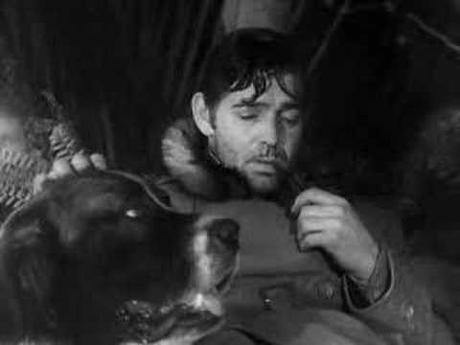
- Ford's Jack Thornton doesn't feature heavily until the second half of the film, and rather quickly it's just him and Buck together in the wilderness. There's a mild retirement home Han Solo/Chewbacca vibe to their rapport since it's a lot of Thornton responding to dialogue no one else can understand, except here it's all non-verbal emoting from Buck and Jack filling in the blanks for him.
- The last film 20th Century Studios released before merging with Fox Studios to become 20th Century-Fox was 1935's Call of the Wild. Now, this year's Call of the Wild is the first film to come from 20th Century Studios since Disney decided to drop Fox from the studio name. That's 85 years in-between films that could be said to have been released by 20th Century Studios, and they're both Call of the Wild adaptations.

